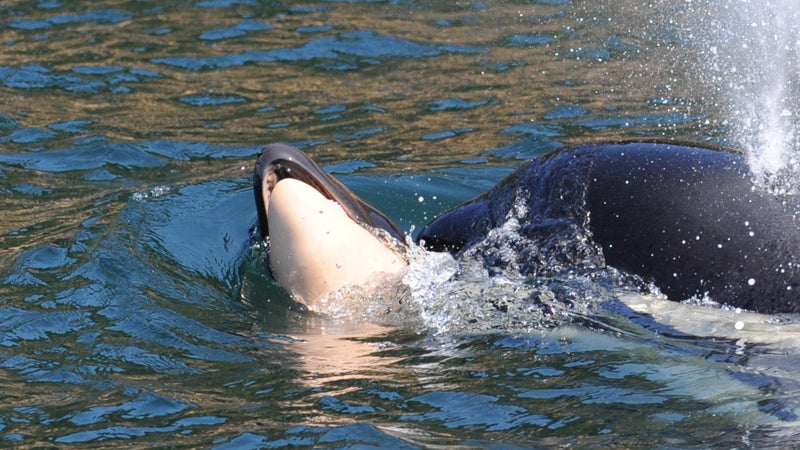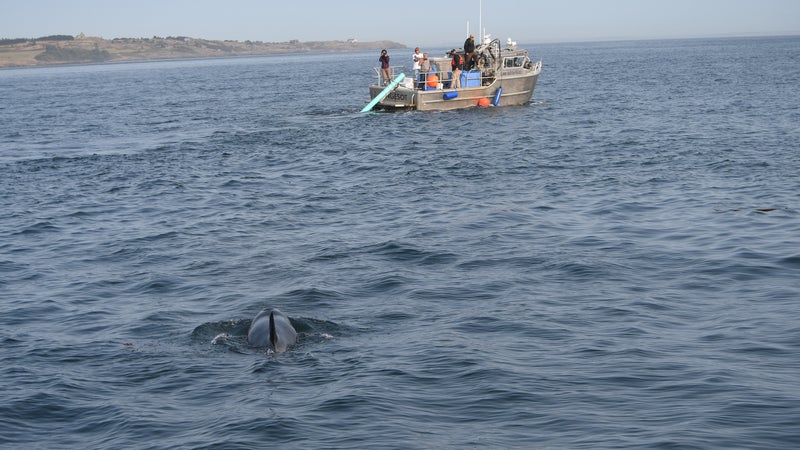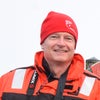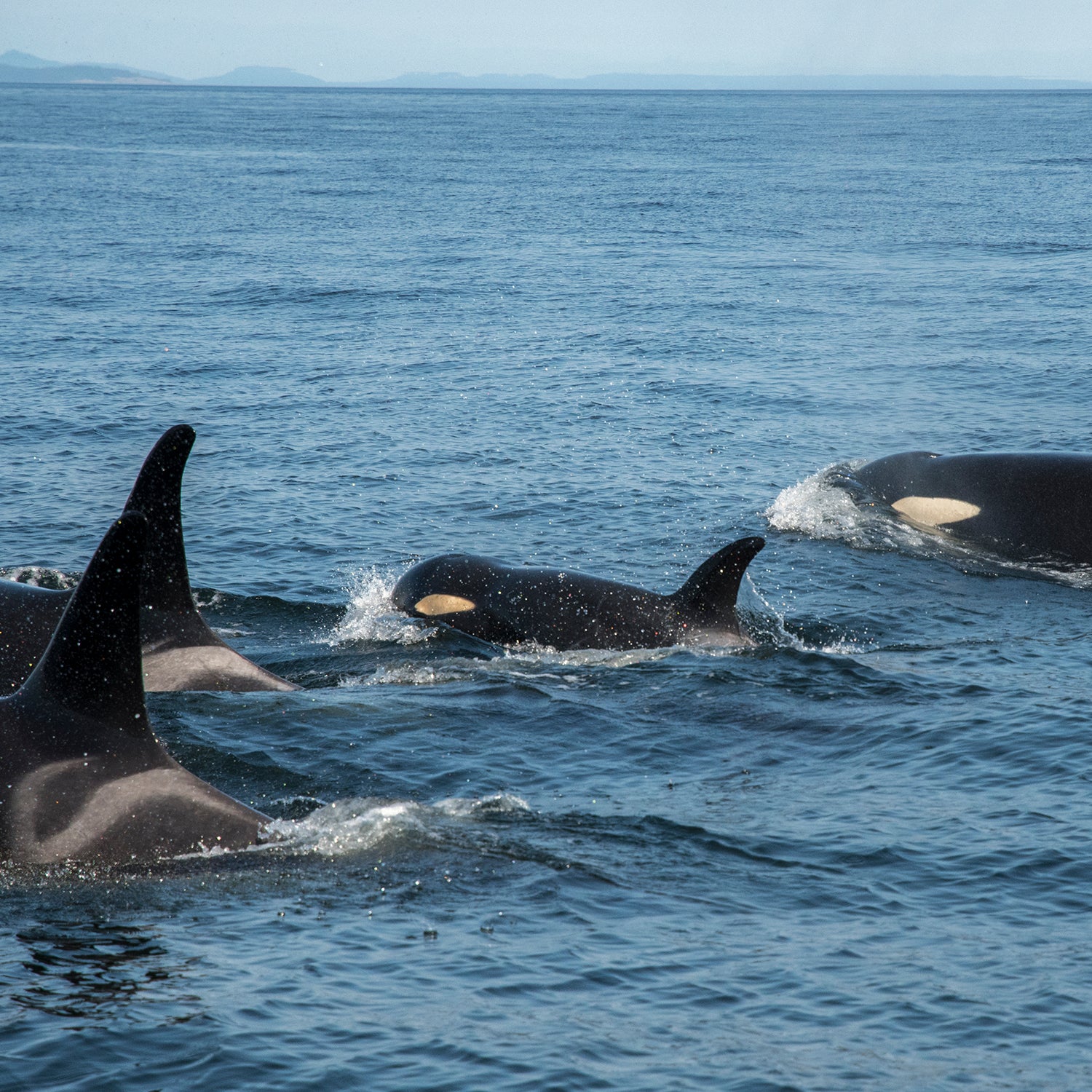The little orca surfaces under an Apocalyptic red sun that’s barely visible behind a shroud of smoke from the wildfires burning across the West.
We’re headed east down the Strait of Juan de Fuca toward Washington’s San Juan Island, pacing a three-year-old killer whale named Scarlet, also known as J50, as she travels with her mother, brother, and older sister in endless pursuit of salmon.
All four whales are part of J Pod, now known around the world for the recent display of grief by pod member J35, or Tahlequah, who for 17 days and 1,000 miles. It was a protest march against all that we’ve done to kill off these magnificent animals by starving them of their food source, poisoning their water and prey, and filling their habitat with the incessant disturbance of vessel traffic.
I’m out here as a volunteer along with a team of whale specialists and a wildlife veterinarian under federal permit to assess and document Scarlet’s health. As she rises for a gulp of the same smoky air we’re breathing, her short, sharp blow is met with groans aboard our small boat. None of us have ever seen such a skinny whale.
For those of us who live among the orcas, Scarlet meant hope. She was a Christmas present, born at the end of December 2014 in the main fjord of the small island I live on, called, coincidentally, Orcas. The island was named after some Spanish viceroy, not the cetaceans, but you wouldn’t know it by the ubiquity of postcards, T-shirts, plushies, and whale watchers.
There’s an informal West Coast cult of the killer whale that’s devoted to J, K, and L Pods, which together make up the Southern Resident killer whales who spend a good part of their year foraging and socializing in the Washington State and British Columbian inland waters that make up the Salish Sea. In 50 years, this clan of supersize dolphins has gone from being vilified and shot by fishermen to being rounded up for marine parks—48 Southern Residents were caught or killed during the capture operations in the sixties and seventies—to becoming the most iconic creature of the Pacific Northwest wilds.

Those wilds are myth now. Ecosystem disruption reaches every part of the region. Climate change is exacerbating wildfires, killing seabirds, and melting the Cascades snowpack earlier—making the streams less suitable for salmon. Our centuries of assault on the rivers, forests, estuaries, and coastlines have done a number on this remarkable place.
And the looking very bad for killer whales, the apex predator in a dysfunctional environment. After the captures stopped, the Southern Resident population climbed from 70 to a high of 98 in 1995. Then they dropped again, to below 80, and were declared federally endangered by Canada in 2001 and by the United States in 2005. In 2015, they were named one of NOAA’s , the animals most at risk of extinction and deserving of extra effort and attention.
The Southern Residents numbered just 78, with no live births in more than two years, when Scarlet came along. Born to a beautiful female named Slick, Scarlet was the first of what became known as the baby boom, with eight calves added to J and L Pods over the following 13 months. A compact black-and-white package of pure exuberance, Scarlet represented everything we love about these playful, caring, intelligent, highly social animals, who stick together tighter than most human families.
I’ve been spending time out here on the water for 15 years, and my favorite hour came one August afternoon in 2015 while drifting off Stuart Island as J Pod hunted the tide rips. Scarlet, now eight months old, was determined to spend more time out of the water than in it. She did breach after full-body breach, stood on her head and waved her tail in the air, slapped her wobbly pectoral fins on the surface, and bumped back and forth between her sister and an aunt, who created a playpen for her with their bodies.
Three years later, half the baby boomers are dead. There are only 75 Southern Residents left, the lowest number in 35 years. And Scarlet is in very bad shape. Peanut head, they call it, when a whale loses so much blubber that you can see the shape of her skull. Healthy orcas do not have necks.
Scarlet is in very bad shape. Peanut head, they call it, when a whale loses so much blubber that you can see the shape of her skull. Healthy orcas do not have necks.
Nearly all the wild orcas seen in the condition Scarlet’s in have died, and Scarlet is a precious female, potentially producing up to six calves over her lifetime. So NOAA and a U.S. and Canadian collection of federal, state, local, and Native American tribal agencies, along with various public and private institutions and nonprofits, are making an unprecedented attempt to save her. Scarlet’s gotten lab tests and a shot of antibiotics, and there’s even been an attempt to feed her live Chinook salmon. Scientists weren’t able to determine whether Scarlet took the salmon, but she’s scheduled for more antibiotics and an anti-parasite shot if she makes it back within range of the wildlife vets in time.
Whether she lives or dies, Scarlet’s poor health and Tahlequa’s grief are just two agonizing illustrations of a larger picture: that the current state of the Southern Resident killer whales is a disgrace and a huge embarrassment for the U.S. and Canada, both of which claim these orcas as totems of all that’s wild and exceptional about them.
We’ve declared the orcas national and regional treasures, bestowed upon them our strongest protections, yet we continue to kill them with building permits, logging, ranching and farming leases, fishing quotas, and dam permits, which all affect the Chinook salmon that these orcas need to survive.
The Canadian government is showing signs of environmental schizophrenia, cutting some Chinook quotas to leave more for the whales while at the same time doing everything it can to build the Trans Mountain Pipeline expansion that will cause a sevenfold increase of oil-tanker traffic through the orcas’ critical habitat.
Beyond the noise of all those ships, a single big spill could be game over for the orcas, who already carry a massive load of persistent organic pollutants in their tissues, which mothers inadvertently pass on to their babies in their milk, giving each newborn significant doses of toxic PCBs and chemical flame retardants during their most critical development period.
On the U.S. side, decades of greed and cowardice have left politicians no place to piss without hitting a third rail like dam removal, turning agricultural land back into salmon habitat, and curtailing treaty-mandated tribal fishing rights.

Stakeholders like commercial and recreational fishermen, farmers who use the water behind the Snake River dams for irrigation and transportation, whale-watch operators, coastal and watershed developers, and property owners have all dug in, firing blame at one another or at easy targets like sea lions, which have learned to feed on the salmon stuck behind dams. Government programs to cull sea lions are another arrogantly engineered human solution to a problem we created, just like the fish hatcheries we built after destroying native runs.
These circular firing squads leave the orcas in the middle, poisoned and starving.
No help can be expected from Washington, D.C., with the current administration and its congressional allies intent on ripping apart the EPA that protects the nation's clean air and water and pays for Salish Sea restoration projects, and hobbling the Endangered Species Act, which is supposed to protect and restore the orcas and the Chinook salmon. The fix here is simple: vote in November.
At the Washington State level, there’s an opportunity that has every feeling of a last chance. Governor Jay Inslee has convened an emergency orca task force and promised to take bold action. There are some good folks on the committee, and their draft action plan is due on his desk October 1.
If the task force comes through, there could be legitimate short and long-term actions to save the Southern Residents, the Chinook salmon, and the habitat that they—and we—depend on. If, however, they punt on the tough stuff, as others have in the past, then the orcas are screwed.
When we left Scarlet after following her that day on the water, she was chugging along at four knots. She hit a wall of current as the tide changed, and her family forged ahead in search of food, which orcas commonly share with their podmates. Scarlet fell a thousand yards behind the others but gamely continued pushing east. We lost sight of her small dorsal fin as the chop came up, her faint blows lost in the smoke from hundreds of fires.
Lead photo: Scarlet, or J50, swimming with her family in early August (Katy Foster/NOAA Fisheries, permit )
Bob Friel (), an author and documentary filmmaker working on a video series called , lives in the San Juan Islands. He is a volunteer with the Marine Mammal Stranding Network and Large Whale Disentanglement Network.


